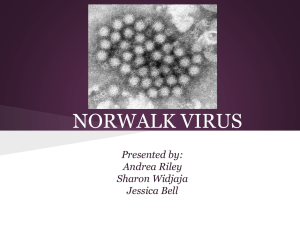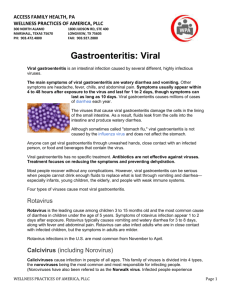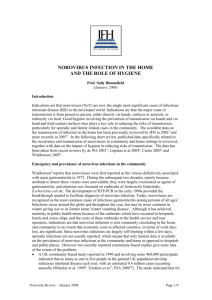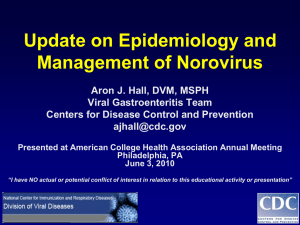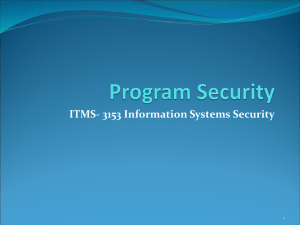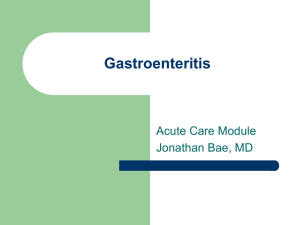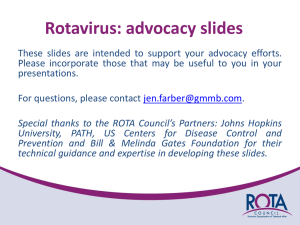Viral Infections of the Gastrointestinal Tract Salivary Gland Infection
advertisement
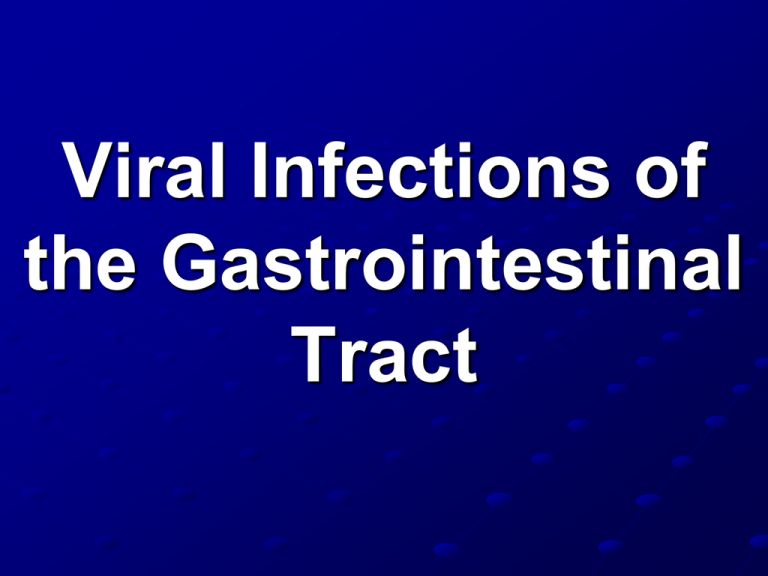
Viral Infections of the Gastrointestinal Tract Salivary Gland Infection: Mumps Virus “to mump” means to grimace or grin. The virion is 120 – 200 nm in diameter Contains in addition to the six major proteins; V (viral) protein and S (soluble) protein. One serotype. Pathogenesis and Pathology Mumps is a systemic viral infection commonly regarded as epidemic parotitis. Transient viremia disseminates the virus to target organs. Virus is actively shed in saliva for as long as 15 days. The presence of virus in saliva is not dependent upon the development of clinical parotitis. Viral involvement of the parotids is neither primary nor an obligate step in infection. Viral replication in the parotids is attended by periductal interstitial edema and local inflammation. Virus is also frequently disseminated to CNS, pancreas, the kidneys, ovaries and testes. The CNS is a common target for mumps virus dissemination. Pancreatic involvement may be mild or severe and hemorrhagic Clinical Features The incubation period is 2-3 weeks. There may be a prodromal phase. The clinical features of mumps reflect the pathogenesis of the infection. Approximately one third of all mumps virus infections occur without recognized symptoms. The feature most characteristics of mumps is salivary gland swelling which is maximal within 48 hours . Parotid tenderness and pain on salivation precede swelling by 2-4 day. After increasing for about 3 days, the inflammation subsides over 7-10 days. Fever is moderate. Diagnosis Virus isolation - Specimens: Saliva, CSF, and Urine - Cell Cultures: PMK or HEK. Serology. Molecular (PCR) Epidemiology Mumps has a worldwide distribution but incidence has dropped dramatically in the developed countries due to vaccination. Epidemics occur in unvaccinated communities at 3 yearly intervals with peak incidence during winter and spring. The maximum incidence is in children aged 5-9 years. Immunity following natural infection is life long. Mumps virus requires a population of about 200.000 people to sustain its circulation. Prevention is achieved by live attenuated vaccine with > 95% efficiency after a single dose. A sustained coverage of 85% or greater is required to prevent transmission of mumps and eliminate disease. a vaccine program with low coverage may have a negative effect despite a decline in the total number of cases. Viral Gastroenteritis It is thought that viruses are responsible for up to 3/4 of all infective diarrhoeas. Viral gastroenteritis is the second most common viral illness after upper respiratory tract infection. In developing countries, viral gastroenteritis is a major killer of infants who are undernourished. Many different types of viruses are found in the gut but only some are associated with gastroenteritis. Viruses Associated with gastroenteritis Rotaviruses Adenoviruses 40, 41 Caliciviruses Norwalk like viruses or SRSV (Small Round Structured Viruses) Astroviruses SRV (Small Round Viruses) Coronaviruses Toroviruses Viruses Found in the gut, not normally associated with gastroenteritis Polioviruses Coxsackie A Coxsackie B Echo Enteroviruses 68-71 Hepatitis A Hepatitis E Adenoviruses 1-39 Reoviruses Found in the gut as opportunistic infection CMV HSV VZV HIV Gastrointestinal Viruses Infants: - Rotavirus A - Adenovirus 40,41 - Coxsackie A24 virus Infants, children, and adults: - Norwalk virus - Calicivirus - Astrovirus - Rotavirus B Groups of Rotaviruses Group A subtypes 1, 2, 3, 4 (main human pathogens) (Further 7 subtypes) also infect animals (monkey, calf, mouse) Group B Infects pigs and rats Found to cause extensive outbreaks in China in past decade Group C Infects Pigs (Occasionally Man) Group D Infects birds Group E Infects pigs Human Pathogens Group A: Main pathogen of infantile diarrhea Group B : Cause epidemic adult diarrhea Group C: Cause human or animal sporadic diarrhea Human Rotavirus 70 nm round, double shelled, enclosing a genome of 11 segments of double stranded RNA. Rotavirus First identified as cause of diarrhea in 1973 Most common cause of severe diarrhea in infants and young children Nearly universal infection by 5 years of age Responsible for up to 500,000 diarrheal deaths each year worldwide Very stable and may remain viable for weeks or months if not disinfected Rotaviruses are found in many different mammals and birds. Reassortment of gene segments can occur and thus create hybrid viruses. Rotaviruses resemble enveloped viruses but they are stable at room temperature and to treatment with detergents, pH extremes of 3.5 to 10 or even repeated freezing and thawing. Infectivity is enhanced by proteolytic enzymes such as trypsin. Proteolytic cleavage of the outer capsid activates the virus and produces an intermediate/infectious subviral particle (ISVP). Pathogenesis Viral replication occurs after adsorption to columnar epithelial cells covering the villi of the small intestine. Shortening and blunting of the microvilli and mononuclear cell infiltration into the lamina propria is observed. Infection prevents the absorption of water causing a net secretion of water and loss of ions which together result in a watery diarrhea. The attendant loss of fluids and electrolytes can lead to severe dehydration and even death. Rotavirus Clinical Features Incubation period 1-3 days Clinical manifestations depend on whether it is the first infection or reinfection First infection after age 3 months generally most severe May be asymptomatic or result in severe dehydrating diarrhea with fever and vomiting Gastrointestinal symptoms generally resolve in 3 to 7 days Rotavirus Complications Severe diarrhea Dehydration Electrolyte imbalance Metabolic acidosis Immunodeficient children may have more severe or persistent disease Rotavirus Immunity Antibody against VP7 and VP4 probably important for protection First infection usually does not lead to permanent immunity Reinfection can occur at any age Subsequent infections generally less severe Rotavirus Epidemiology Reservoir Human-GI tract Transmission Fecal-oral, fomites Temporal pattern Fall and winter (temperate areas) Communicability 2 days before to 10 days after onset Epidemiology Infection with rotaviruses has a worldwide distribution. Transmission is by the oral fecal route. Outbreaks are common in preschool children, among day care centers and hospitalized infants. Most children are infected by the age of 4 years during the cooler months of the year. Risk Groups for Rotavirus Diarrhea Groups with increased exposure to virus Children in child care centers Children in hospital wards (nosocomial rotavirus) Caretakers, parents of these children Children, adults with immunodeficiency related diseases (e.g. SCID, HIV, bone marrow transplant) Prevention Vaccines are available since the late 1990’s. Animal; rhesus monkey and bovine rotaviruses were utilized. Live tetravalent vaccine was tried from August 1998 to October 1999 and was stopped because of association with intussusception (15 cases in 1.5 million doses). ® Rotavirus Vaccine (RotaTeq ) Approved by FDA in February 2006 Contains five reassortant rotaviruses developed from human and bovine parent rotavirus strains Vaccine viruses suspended in a solution of buffer (sodium citrate and phosphate) and stabilizer Contains no preservatives or thimerosal ® Rotarix Rotavirus Vaccine Approved by FDA in April 2008 Contains one strain of live attenuated human rotavirus Two oral doses at 2 and 4 months of age (minimum interval 4 weeks) Minimum age 6 weeks Maximum age 24 weeks RotaTeq Vaccine Efficacy Phase III trials included more than 70,000 infants in 11 countries Efficacy All rotavirus disease - 74% Severe rotavirus disease - 98% Physician visits for diarrhea-86% reduction Rotavirus-related hospitalization-96% reduction Efficacy of fewer than 3 doses is not known N Eng J Med 2006;354:23-33 Rotavirus Vaccine Recommendations Routine immunization of all infants without contraindications Administered at 2, 4, and 6 months of age* Minimum age of first doses is 6 weeks First dose should be administered between 6 and 12 weeks of age (until age 13 weeks) Do not initiate series after 12 weeks of age Rotavirus Vaccine and Intussusception* Within 42 days of vaccination Within 1 year of vaccination Vaccine Placebo Recipients Recipients 6 cases 5 cases 13 cases 15 cases Rotavirus Vaccine Adverse Reactions Vomiting 15% Diarrhea 24% Nasopharyngitis 7% Fever 43% No serious adverse reactions reported *data shown are for RotaTeq MMWR 2006;55:(RR-12):1-13. Astroviruses have a five or six-pointed star shape of 28-30 nm in diameter with an icosahedral symmetry. They typically cause outbreaks of gastroenteritis as a result of common source contamination (water, shellfish, food service). Spread is by the fecal-oral route. Outbreaks occur year around in schools, resorts, hospitals, nursing homes, restaurants and cruise ships. They are similar clinically to rotavirus disease. Caliciviruses and Related Agents Caliciviruses are 27-38 nm, non enveloped, icosahedral viruses with a (+) ss RNA genome (7500 bases). Norwalk agent (now called Norovirus) was discovered by EM in stool from adults during an epidemic of an acute gastroenteritis in 1968 in Norwalk, Ohio. Noroviruses Noroviruses (genus Norovirus, family Caliciviridae) are a group of related, single-stranded RNA, nonenveloped viruses that cause acute gastroenteritis in humans. Norovirus was recently approved as the official genus name for the group of viruses provisionally described as “Norwalk-like viruses” (NLV). Currently, there are at least five norovirus genogroups (GI, GII, GIII, GIV and GV), which in turn are divided into at least 31 genetic clusters. Virus Transmission Noroviruses are transmitted primarily through the fecal-oral route, either by consumption of fecally contaminated food or water or by direct person-toperson spread. Environmental and fomite contamination may also act as a source of infection. Good evidence exists for transmission due to aerosolization of vomitus that presumably results in droplets contaminating surfaces or entering the oral mucosa and being swallowed. No evidence suggests that infection occurs through the respiratory system. Noroviruses are highly contagious and as few as 10 viral particles may be sufficient to infect an individual. During outbreaks of norovirus gastroenteritis, several modes of transmission have been documented; for example, initial foodborne transmission in a restaurant, followed by secondary person-to-person transmission to household contacts. Although presymptomatic viral shedding may occur, shedding usually begins with onset of symptoms and may continue for 2 weeks after recovery. It is unclear to what extent viral shedding over 72 hours after recovery signifies continued infectivity Clinical Presentation The incubation period for norovirus - associated gastroenteritis in humans is usually between 24 and 48 hours (median in outbreaks 33 to 36 hours), but cases can occur within 12 hours of exposure. Norovirus infection usually presents as acuteonset vomiting, watery non-bloody diarrhea with abdominal cramps, and nausea. Low-grade fever also occasionally occurs Dehydration is the most common complication, especially among the young and elderly, and may require medical attention. Symptoms usually last 24 to 60 hours. Recovery is usually complete and there is no evidence of any serious long-term sequalae. Studies with volunteers given stool filtrates have shown that asymptomatic infection may occur in as many as 30% of infections, although the role of asymptomatic infection in norovirus transmission is not well understood. Immunity to Norovirus Mechanisms of immunity to norovirus are unclear. It appears that immunity may be strain-specific and lasts only a few months; therefore, given the genetic variability of noroviruses, individuals are likely to be repeatedly infected throughout their lifetimes. This may explain the high attack rates in all age groups reported in outbreaks. Recent evidence also suggests that susceptibility to infection may be genetically determined, with people of blood group O being at greatest risk for severe infection. Disease burden of Norovirus Gastroenteritis CDC estimates that 23 million cases of acute gastroenteritis in USA are due to norovirus infection, and it is now thought that at least 50% of all foodborne outbreaks of gastroenteritis can be attributed to noroviruses. Among the 232 outbreaks of norovirus illness reported to CDC from July 1997 to June 2000, 57% were foodborne, 16% were due to person-to-person spread, and 3% were waterborne; in 23% of outbreaks, the cause of transmission was not determined. Most food borne outbreaks of norovirus illness are likely to arise through direct contamination of food by a food handler immediately before its consumption. Outbreaks have frequently been associated with consumption of cold foods, including various salads, sandwiches, and bakery products. Liquid items (e.g., salad dressing or cake icing) that allow virus to mix evenly are often implicated as a cause of outbreaks. Food can also be contaminated at its source, and oysters from contaminated waters have been associated with widespread outbreaks of gastroenteritis. Other foods, including raspberries and salads, have been contaminated before widespread distribution and subsequently caused extensive outbreaks. Waterborne outbreaks of norovirus disease in community settings have often been caused by sewage contamination of wells and recreational water. Diagnosis of Norovirus Real time (RT-PCR) detects the norovirus RNA and can be used to test stool and emesis samples, as well as environmental swabs in special studies. Identification of the virus can be best made from stool specimens taken within 48 to 72 hours after onset of symptoms, although good results can be obtained by using RT-PCR on samples taken as long as 5 days after symptom onset. Virus can sometimes be found in stool samples taken as late as 2 weeks after recovery. Older methods for diagnosis include direct and immune electron microscopy of fecal specimens, and detection of a fourfold increase of specific antibodies in acute and convalescent phase blood samples. Several commercially available enzyme-linked immunosorbent assays for detection of virus in stools have been developed but await further evaluation regarding sensitivity and specificity. Sequencing of norovirus strains found in clinical and environmental samples has greatly helped in conducting epidemiologic investigations by linking cases to each other and to a common source and by differentiating outbreaks that were mistakenly connected. In addition to microbiological techniques, several epidemiologic criteria have been proposed for use in determining whether an outbreak of gastroenteritis is of viral origin. Kaplan's criteria Viral etiology is suspected if: 1) a mean (or median) illness duration of 12 to 60 hours, 2) a mean (or median) incubation period of 24 to 48 hours, 3) more than 50% of people with vomiting, and 4) no bacterial agent previously found. Although quite specific, these criteria are not very sensitive, and therefore the possibility of a viral etiology should not be discarded if the criteria are not met. Management of Norovirus Infection No specific therapy exists for norovirus gastroenteritis. Symptomatic therapy consists of replacing fluid losses and correcting electrolyte disturbances through oral and intravenous fluid administration. Prevention Relatively simple measures, such as correct handling of cold foods, strict hand washing after using the bathroom and before handling food items, and paid sick leave, may substantially reduce foodborne transmission of noroviruses. Prevention of norovirus disease spread via droplets from vomitus (person to person transmission) should focus on methods to limit transmission including isolation precautions (e.g., cohort sick patients in a healthcare facility) and environmental disinfection. Adenovirus Gastrointestinal Disease Diarrhea Types 40 and 41 Intussusception Mesenteric adenitis. Types 1, 2, 5 and 6. Celiac Disease Type 12. Structural homology between E1B protein and α-gliadin Enteric Adenoviruses Fastidious enteric adenovirus types 40 and 41 are associated with endemic gastroenteritis, usually in young children and neonates. Can cause occasional outbreaks. Possibly the second most common viral cause of gastroenteritis (7-15% of all endemic cases). Similar disease to rotaviruses. Most people have antibodies against enteric adenoviruses by the age of three years. Diagnosed by electron microscopy or by the detection of adenovirus antigens in faeces by ELISA or other assays. Other Possible Diarrhoeal Viruses Coronaviruses RNA viruses with a crown-like appearance No convincing evidence to be associated with gastroenteritis at present Small Round Viruses Small virus-like particles with a smooth surface, 2228nm in diameter May possibly be parvoviruses, enteroviruses, or cubic bacteriophages Occasionally seen in the faeces of endemic or epidemic cases of gastroenteritis Gastrointestinal Viruses Virus Genome Typical disease incubation Duration Rotaviruses: Group A, B, C ds-segmented RNA Major cause of diarrhea in children 1-3 days 24-56 h 5-8 days 3-7 days Caliciviruses Norwalk agents ssRNA Infects adults and children Epidemic viral gastroenteritis 1-3 days 18-24 h 1-3 days 12-48 h EAd 40,41 Linear dsRNA diarrhea in children 7-8 days 8-12 d Astrovirus +ssRNA Infects mainly children and elderly 1-4 days 1-4 d
